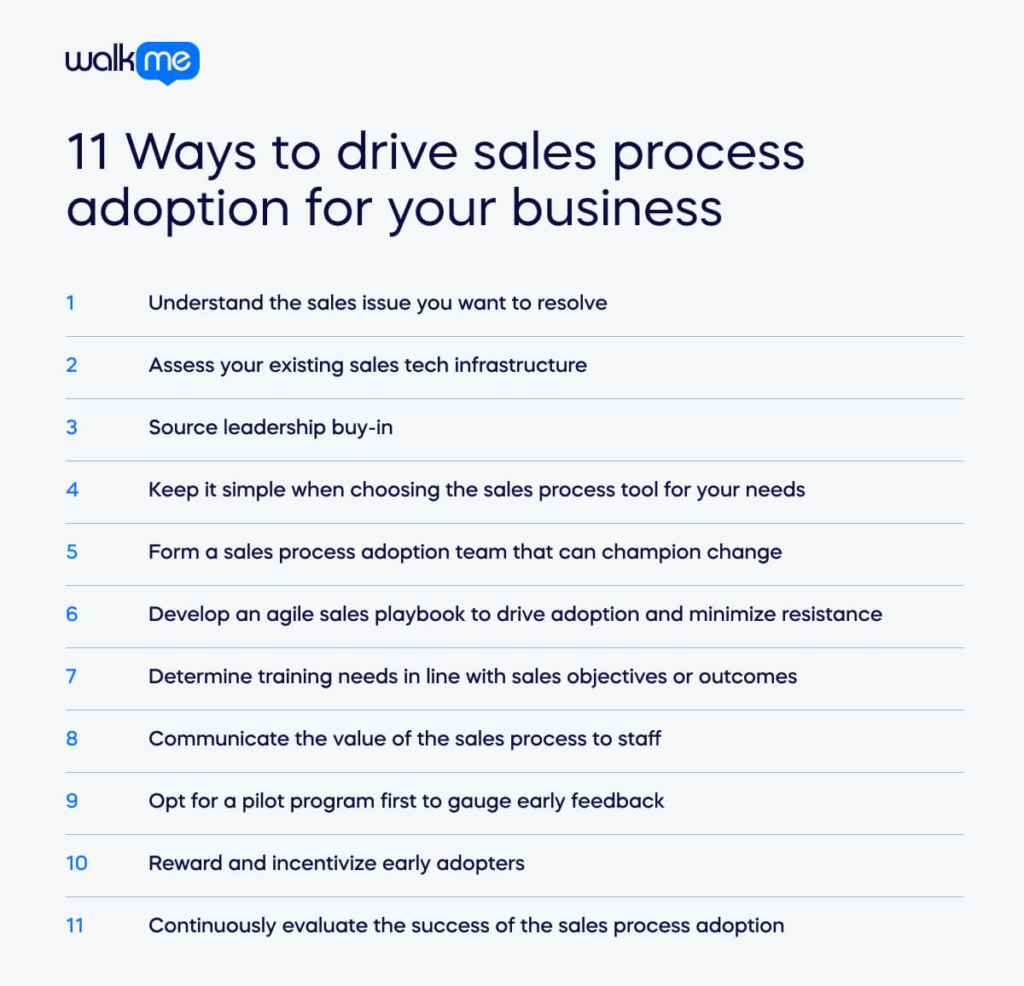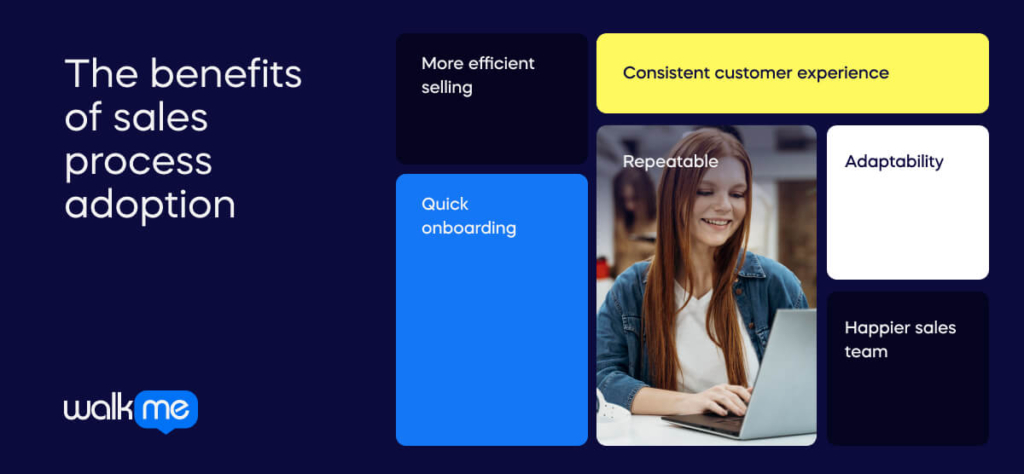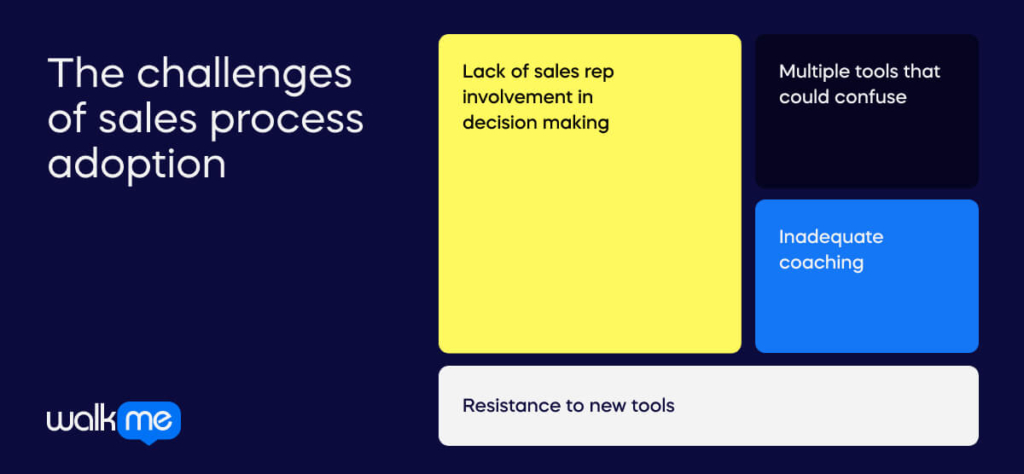The post-pandemic era has introduced significant, lasting changes to buying and selling. This has led to longer sales cycles because of new buying behaviors and hesitations in decision-making.
Implementing scalable sales processes that improve the customer experience has become crucial, especially in enterprise sales. Success relies on adopting effective processes. This depends on whether salespeople can see the value of these new sales processes.
A detailed sales process framework can guide sellers through every step, ensuring a smooth customer journey. But, the effectiveness of these frameworks is often compromised. This is because there is a lack of focus on incorporating these processes into sales reps’ daily routines.
In this article, we will focus on the 11 people-focused ways that you can drive sales process adoption for your business. Next, we will also explore sales process adoption and its benefits and challenges.
What is sales process adoption?
Sales process adoption occurs when sales representatives grasp the importance of this new approach to their team. This leads them to incorporate it into their daily activities. A sales process outlines a sequence of actions for salespeople to follow.
This guides a prospect from the initial lead stage to becoming a customer. This systematic method supports sellers in securing deals by adhering to established best practices.
Documenting the sales process aids in streamlining the lead management workflow. But it also boosts efficiency.
It equips sales teams with a blueprint of repeatable steps. This enhances the precision of sales tracking, forecasting, and the general oversight of sales activities.
11 Ways to drive sales process adoption for your business

Here are the 11 ways to drive the sales adoption process for your organization:
- Understand the sales issue you want to resolve
Do a readiness assessment aligned with your current framework to improve a sales process. Engage with your sales representatives to better understand their practices and behaviors.
Learn about their approach to the different stages. You also need to be aware of their communication strategies with prospects.
Next, understand the common challenges or objections they encounter. Dive into these discussions to unearth gaps, inconsistencies, and areas ripe for improvement.
Next, investigate what causes the most resistance and frustration among your team. Organize a meeting to listen to their feedback.
This will help you identify which sales stages are the most problematic. This conversation can provide valuable real-life insights into crafting an efficient sales process.
Reflect on what aspects of your process are working and which ones aren’t. Recognizing the ineffective parts is critical for pinpointing necessary adjustments to boost performance. Tailoring your process to better suit the needs of your sales reps can empower them to close deals more.
When evaluating each sales process step, ask yourself a few key questions. Are all steps delivering the intended results? Or are they as effective as when first implemented? Are all the steps up to date and efficient? Is there a way to prioritize actions better?
This evaluation will help you refine your sales process for greater success.
- Assess your existing sales tech infrastructure
Before adopting a new sales process tool, check all your current sales tools.
Map out how these tools interconnect throughout the sales process. This mapping creates a technological blueprint for your sales operations. It highlights the expected interactions between sales representatives and these tools to progress leads through the sales funnel.
After completing this exercise, consult with your sales leaders. The aim is to find potential improvements to the existing sales processes.
You might discover redundant tools that you could remove. You may also find areas where you can streamline with new tools or methods.
This effort goes beyond just aiding in sales process adoption. Creating a visual summary of your current sales tech stack offers a significant resource for the team. You should display this summary at each team member’s workstation. It can act as a continuous point of reference.
- Source leadership buy-in
Adopting a new sales process requires adjustments from your sales team. Embedding new habits takes time to become instinctive. Encountering too many hurdles or changes risks losing momentum and deviating from the path.
To counter this, ensuring your frontline sales managers are committed to the new approach is crucial. You should equip them with the skills to communicate the message.
This preparation allows them to tackle resistance or queries. Managers who succeed in this area are well-informed and adept at addressing challenging questions.
They play a pivotal role in sustaining the new process. They can monitor and motivate their teams to embrace the changes.
- Keep it simple when choosing the sales process tool for your needs
Avoid complex sales processes that can lead to confusion and neglect. Eliminating unnecessary steps is crucial for your salespeople to adopt a new sales process. Any excess steps might block the process or dampen the enthusiasm for following it.
Thus, streamlining the new sales process to make it clear and simple is essential. The simpler the process, the more likely a sales representative will adopt it.
This is especially true if it simplifies their job compared to before the adoption. Hence, ease of use should be a priority from the start, long before the process reaches the sales team.
Keep open lines of communication with the sales team throughout the development and rollout of the new process.
Doing so reduces the chance of problems arising after investing time and effort into creating a new process. Early and frequent engagement with the team ensures successful sales process adoption.
- Form a sales process adoption team that can champion change
Cultivate support for your new process by forming a sales process adoption team. Address potential objections by working with sales leadership to develop your training program. Having the backing of sales leadership from the start helps to preempt any issues that might arise from the implementation.
Don’t just include leaders in this team. Look for a representative who has succeeded with your new process and can act as an internal advocate. Their success can generate excitement among the team. This is because salespeople often seek to mimic the success of their peers.
If one rep within this team improves their performance, it will likely intrigue others. This approach turns adopting the new process into a team effort. Thus, it feels less like an obligation and more like a shared path to success.
- Develop an agile sales playbook to drive adoption and minimize resistance
A sales process playbook will help you highlight various factors important for the sales process. This will include your company’s goals, sales processes, and how sales representatives can use sales tools at their disposal.
It offers sales reps an extra tool to understand how these processes are part of the broader sales strategy. It will also underscore the importance of following them.
Ensure your sales processes maintain flexibility rather than rigidity. Include scenarios in the playbook that allow for adaptability, enabling sales reps to customize the process for particular client behaviors.
It’s also vital that the sales process moves leads effectively through the sales funnel. This helps avoid frustrating barriers and unnecessary interruptions. You may need to reassess and revise the process to reduce resistance if you encounter persistent issues.
- Determine training needs in line with sales objectives or outcomes
Once you’ve set up the new sales process, ensure your sales team is well-supported. They must receive the necessary training and on-the-job coaching.
Additionally, quick and effective onboarding of new salespeople is a key competitive edge. Investing in comprehensive sales training programs equips new sales representatives with the essential skills and knowledge for success in the sales process.
Continual learning opportunities are vital. They help sales reps refine their strategies and execution. Additionally, these opportunities give managers visibility into the team’s performance. It highlights who is excelling and who may need extra help.
A digital adoption platform can transform your approach to sales training and onboarding. It helps produce personalized and engaging learning content.
This method empowers the sales team to learn as part of their daily work. This improves their learning experience and their ability to enhance the customer experience.
- Communicate the value of the sales process to staff
Demonstrating the value of the new sales is crucial for user adoption. Highlighting the advantages and significance of any new tool or process is essential for gaining the sales team’s buy-in. Without this step, achieving their support is challenging.
You can achieve this by highlighting positive outcomes and results from those who have already implemented the process.
Focus on specific benefits to convey the new process’s value to the team. For instance, explain how the process speeds up their tasks instead of slowing them down.
Show them it allows more time to create new opportunities, build their pipeline, and close deals.
Show the process’s ability to enhance their pitching skills and help the progression of deals through various stages. Highlight how it prepares them to close bigger and more complex deals.
Additionally, consider any benefits specific to your industry. Make sure to clearly articulate the value at the beginning and end of the rollout and training process. Doing so will help your sales team get excited about adopting the sales process and ensure they follow through.
- Opt for a pilot program first to gauge early feedback
Before rolling out the new sales process to the entire team, initiate a pilot program to increase adoption gradually. Start with a smaller-scale approach. Motivate a select group of salespeople to incorporate a few steps from the new sales process tool rather than adopting everything all at once.
This method allows them to familiarize themselves with each step incrementally. They can understand the outcomes they achieve, facilitating a smoother transition to the new sales process tool.
After they have mastered the initial steps, you can encourage the sales representatives to experiment with other tool features. Remember that urging employees to use all features from the start can overwhelm and demotivate them, often leading to confusion.
- Reward and incentivize early adopters
Acknowledge and reward early adopters who adhere to the process and excel. Introducing experiential learning like gamification can make the adoption of the sales process more appealing.
Gamifying sales turns selling into a competitive and enjoyable activity. Sales representatives, who are naturally competitive, find motivation in this environment. Incorporating competition and rewarding winners can greatly enhance team enthusiasm, even for small prizes.
You can also offer incentives for completing training early. This can change the perception of training from a chore to an appealing opportunity.
This approach also identifies proactive team members. Recognizing these individuals can help identify potential internal champions for future rollouts, benefiting the sales operation as a whole.
- Continuously evaluate the success of the sales process adoption
You must track and continuously review sales performance metrics and objectives to ensure your sales process is effective. It’s a fundamental principle that you cannot improve what you don’t measure.
Initiate this process by gathering regular feedback from your sales team to pinpoint potential areas for enhancement.
Position the buyer as the main focus to achieve the highest return on investment from your sales process adoption. Evaluate the effectiveness of your sales process by observing how buyers react to it.
Every quarter, undertake a win-loss analysis by interviewing a select group of buyers who have navigated through your sales process. Their insights will provide valuable perspectives, enabling you to further refine and improve the sales process.
The benefits of sales process adoption

The benefits of sales process adoption are:
- More efficient selling: Adopting a structured sales process helps focus on key activities. This means conversion rates and reducing time wasted on non-selling tasks, ultimately boosting revenue.
- Quick onboarding: Accelerates the training period for new sales reps, enabling them to begin selling faster.
- Consistent customer experience: This ensures that all potential customers receive the same high-quality service, enhancing brand reputation and fostering trust and loyalty.
- Repeatable: Assists you in establishing a sales process that can be executed in the same manner by the entire sales team, eliminating confusion or errors.
- Adaptability: Helps you prepare for the unexpected, particularly in a fast-growing small business environment where new technologies, products, services, and market changes can arise. Incorporate flexibility into your sales process to ensure you can adapt as needed.
- Happier sales team: Clear expectations and a solid sales process improve rep engagement and increase retention. This makes meeting or exceeding sales quotas a regular achievement.
The challenges of sales process adoption

Alternatively, the challenges of sales process adoption include:
- Lack of sales rep involvement in decision making: Sales tool adoption struggles when purchases are based on buyers’ needs rather than users. Leadership often chooses tools without sales rep input. This leads to selecting features focused on managerial insights rather than easing sales rep tasks.
- Multiple tools that could confuse: The abundance of existing tools can confuse reps about which to use for specific tasks. This can complicate their work and lead to inefficiency. This confusion creates a disjointed system that hinders sales and leads to revenue loss.
- Inadequate coaching: General training fails to meet individual rep needs. This can leave them needing help with how to best use the tools. Sales reps may revert to familiar, outdated methods without a coaching plan, resisting new technologies.
- Resistance to new tools: The sales team might view new tools as surveillance, fearing negative repercussions from management. However, using old tools prevents access to advanced analytics and contributes to poor data quality and decision-making.
The future of sales process adoption
Achieving effective sales adoption is difficult. But, putting the right resources and time into planning a strategy usually yields significant benefits. Understanding your sales team and their motivations is crucial.
Start by pinpointing their challenges. This allows you to present your new sales strategy as a solution designed to enhance their sales performance.
It’s also important to involve your sales representatives in the selection process of sales tools and commit resources to their implementation.
Such involvement creates a sense of ownership among the team. It also enhances their commitment and understanding of the tools.
Additionally, effective communication is key. Make sure to articulate the benefits of the new process for achieving sales goals.
You should also provide clear instructions on utilizing the sales playbook and training materials. Lastly, remain open to feedback from every sales team member. This approach promotes a supportive atmosphere that is vital for successful adoption.
A digital adoption platform (DAP) enables you to streamline the daily tasks of sales reps, such as pipeline management, custom quote creation, and closing deals, making these processes more efficient. This reduces the potential for challenges and mistakes that sales reps might encounter.


